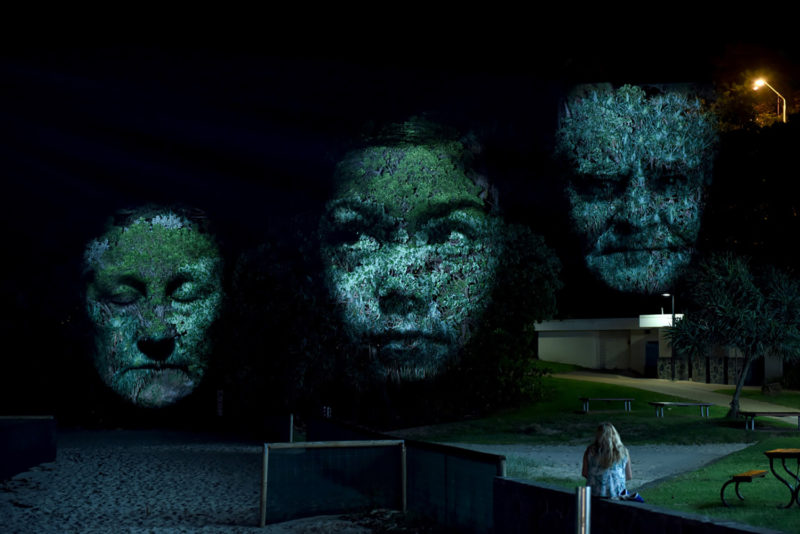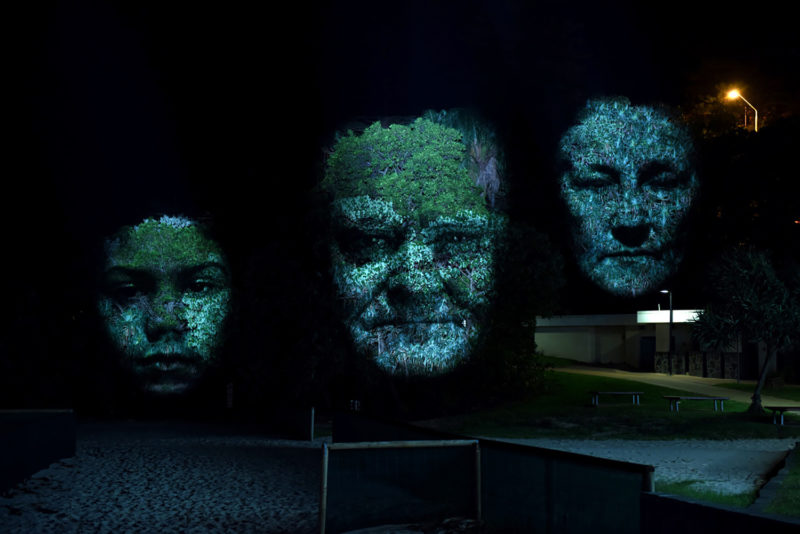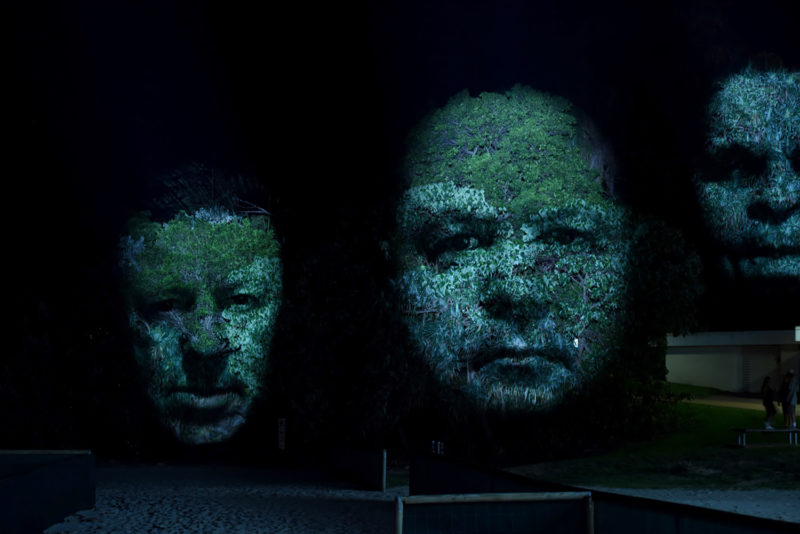Project Description
Project Description
3 synchronised video, projections, existing trees.
This project honours local Aboriginal man Churaki, who, as the surf bathing craze first hit Coolangatta beaches in the early 1900s, became renowned for carrying out many daring rescues in the surf at Greenmount. Churaki received a Royal Humane Society award for bravery and was honoured at the foundation meeting of the Tweed Heads/Coolangatta Surf Club. By the 1930s, Greenmount headland was still being referred to as Churaki Hill, but sometime in the intervening years the name fell into disuse. Churaki Hill pays tribute to this legacy by celebrating a rich lineage of saltwater people who have been closely linked to these waters and who have a connection to the spirit of the Churaki story, embodying an essence of generosity, strength and love of saltwater country.
CHURAKI’S STORY
Churaki was a Bundjalung man who lived in the Tweed region in the late 1800s and early 1900s. He was the son of respected Aboriginal elder Caomoi, renowned for his large imposing stature and feats of endurance.
Churaki was known for carrying out many daring rescues in the surf at Greenmount before the first surf club was formed there in 1911. Caomoi reportedly asked his son to watch over the surf bathers at Greenmount when the surf bathing craze hit and drownings became common, after the railway line from Brisbane and Ipswich to Tweed Heads opened in 1903.
It was considered Churaki’s cultural obligation to keep visitors to their country safe. During this time, Greenmount headland became known as “Churaki Hill”.
Churaki’s deeds were honoured at the foundation meeting of the Tweed Heads Coolangatta Surf Life Saving Club and with a Letter of Commendation for bravery from the Royal Humane Society.
This project pays tribute to Churaki’s legacy by celebrating a rich lineage of saltwater people who have a connection to these waters and to the spirit of the Churaki story, embodying an essence of generosity, strength and love of saltwater country.
PETER TURNER
Peter Turner is the founder of the Kirra Surf store and was a Gold Coast councillor for eight years in the ’90s. His family have a connection to Churaki’s story that goes back generations.
“My grandfather Jim Turner was always known as Caomoi (the name of Churaki’s father),” says Peter. “When he was probably around teenage years, he’s offended this very tall Aboriginal man called Caomoi. Caomoi chased my grandfather off the wharf at Chinderah waving a spear … Everyone in town heard the story and tagged him with that nickname for the rest of his life. And my father got the nickname Young Caomoi.”
Years later, when Peter successfully redeveloped the Kirra Surf site, he retired from the retail business, bought a catamaran and sailed through South-East Asia in search of surf. He named his dream boat Churaki. “Caomoi had a son Churaki and that’s why I named my boat Churaki, because I’m the son of Caomoi.”
WAYNE “RABBIT” BARTHOLOMEW
Rabbit is the 1978 world surfing champion and many of the pivotal moments in his surfing life happened at Greenmount. “My first recollections of Greenmount were going down there and seeing Ron Rico, the hypnotist, and all the entertainment they had was phenomenal,” he recalls.
The first-time Rabbit sat on a surfboard was at Greenmount, but it ended badly a bodysurfer collided with him and he didn’t try and surf again for a year. He remembers legendary lifeguard John Cunningham rescuing people in huge seas and beach hire operator Billy Rachinger letting him ride his inflatable surf-o-planes. He also recalls surfers jumping in the ocean at Greenmount Point fully dressed and swimming to Kirra to escape police looking to run them out of town under the vagrancy laws of the day.
“I remember that whole Summer of Love watching it all happen as an 11 or 12-year-old. It was a really colourful time, they were really colourful characters.”
JOEL SLABB
Joel is a local Indigenous surfer from Fingal, just over the border in northern NSW. He began Juraki surf and culture, an Indigenous not-for-profit entity that is committed to creating, supporting and partnering in community activities, programs and sporting events that give Indigenous youth culturally sensitive opportunities from an Indigenous perspective.
In doing this, Joel and Juraki Surf and Culture pay homage to Churaki’s legacy.
He has also organised the Juraki Surf Invitational at Fingal to bring Indigenous surfers together from across Australia.
“We want to get kids back in the water but we want to support people who want to make it a lifestyle and go and compete,” says Joel.
Joel first sought permission from local elders to use the name Juraki, an acronym for Churaki. Joel decided to change the spelling to avoid confusion with the man himself, while still paying tribute to his legacy. Churaki and his father Caomoi are buried at Fingal Cemetery so Joel and his family grew up with stories of their deeds.
“He was willing to give up his life to rescue someone else,” says Joel. “He wasn’t out for glory or recognition.”
MIBIN GUGIN GALI SLABB
Mibin is one of the next generation of young Indigenous surfers enjoying the coastal lifestyle of the region. Aged nine, his full name Mibin Gugin Gali Slabb means “eagle from the north”.
His favourite thing to do is “stay in the water all day,” and the best part about surfing is “when you do something new.”
He started surfing at the age of three. “He really just took to it pretty easy because his brother was already into it and his mum and dad both surf so he had no choice,” says Mibin’s father, Josh.
Josh was a champion junior surfer himself and Mibin’s mum Chris also surfs and is a talented artist. Unsurprisingly, Mibin’s favourite people to surf with are his family. “Sometimes we do mini-surf comps, just muck around,” he says.
Mibin has grown up with the story of Churaki – “this dude that saved people”.
AUNTY JOYCE SUMMERS
Aunty Joyce is community Elder and an award-winning artist who has taught art and culture in local schools and TAFE colleges for many years.
She became interested in Churaki’s story when she was assisting local historian Robert Longhurst with Indigenous research for his local history book, From Tallebudgera to the Tweed. Based on her research, she wrote a poem telling the story of Churaki’s life.
“It tells about his spirit, that he was a good man. He’d obviously been exposed to some Christianity, one way or the other, but he could also practice his culture so he’d learned to walk in both worlds.”
Aunty Joyce believes Churaki felt he had a cultural obligation to look after visitors to his country. “When you do a Welcome to country then you are responsible for those people you welcomed on to that country. He’s obviously accepted these people on to his country so he feels responsible,” she says.
JACKIE MCDONALD
Jackie is a descendant of the Nganduwal people of the Tweed Valley and of the Yugambeh people of the Gold Coast. She is a dedicated advocate for the Indigenous community and, in particular, for respecting Aboriginal Cultural heritage. “I’ve struggled with the idea that our Aboriginal heritage seems to take second place to European heritage,” she says.
Like Aunty Joyce, she learned of Churaki’s story while helping local historian Robert Longhurst with research for his book, From Tallebudgera to the Tweed. She discovered a letter to a newspaper in 1921 after Churaki’s death, detailing Churaki’s deeds.
It had been Churaki’s wish to be buried with all his personal papers to prove that he had lived a virtuous life and ensure his entry to heaven. His friend Captain Joseph Kirkwood, had promised to fulfill Churaki’s dying wish, but later realised he had overlooked his bravery commendation.
“The Captain realised after his death that there was one certificate he hadn’t buried with him and that was that Royal Humane Society Letter of Commendation for bravery and so he wrote to the papers. And without that, the evidence of Churaki being the first lifesaver could have been lost forever.”


